Developing a Corporate Strategy for the Movie Exhibition Industry
VerifiedAdded on 2023/04/25
|10
|2864
|341
AI Summary
This essay evaluates the movie exhibition industry using Porter's five force model and suggests ways to achieve competitive advantage. It discusses the bargaining power of buyers and suppliers, threat of substitutes and new entrants, and rivalry among competitors.
Contribute Materials
Your contribution can guide someone’s learning journey. Share your
documents today.
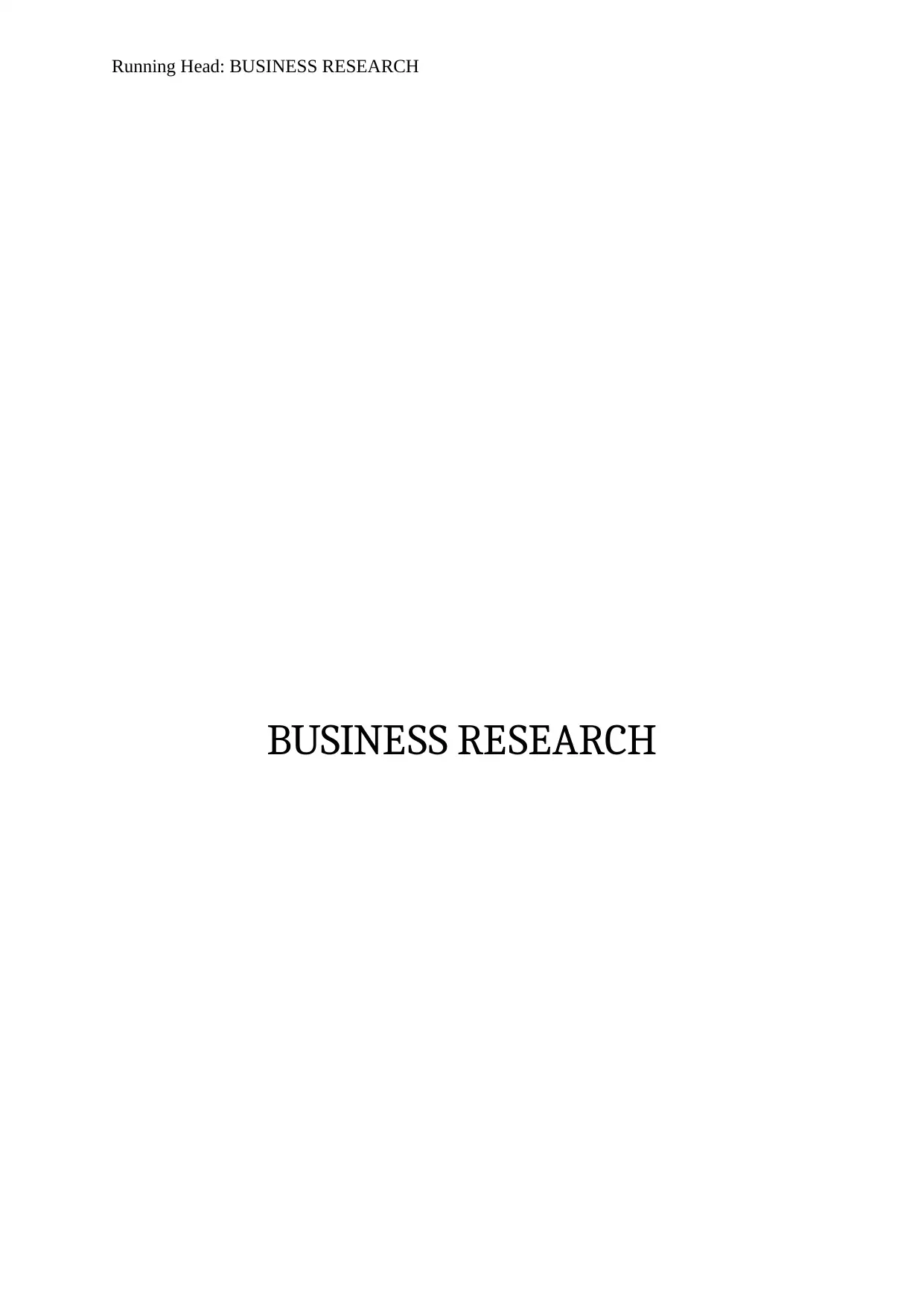
Running Head: BUSINESS RESEARCH
BUSINESS RESEARCH
BUSINESS RESEARCH
Secure Best Marks with AI Grader
Need help grading? Try our AI Grader for instant feedback on your assignments.
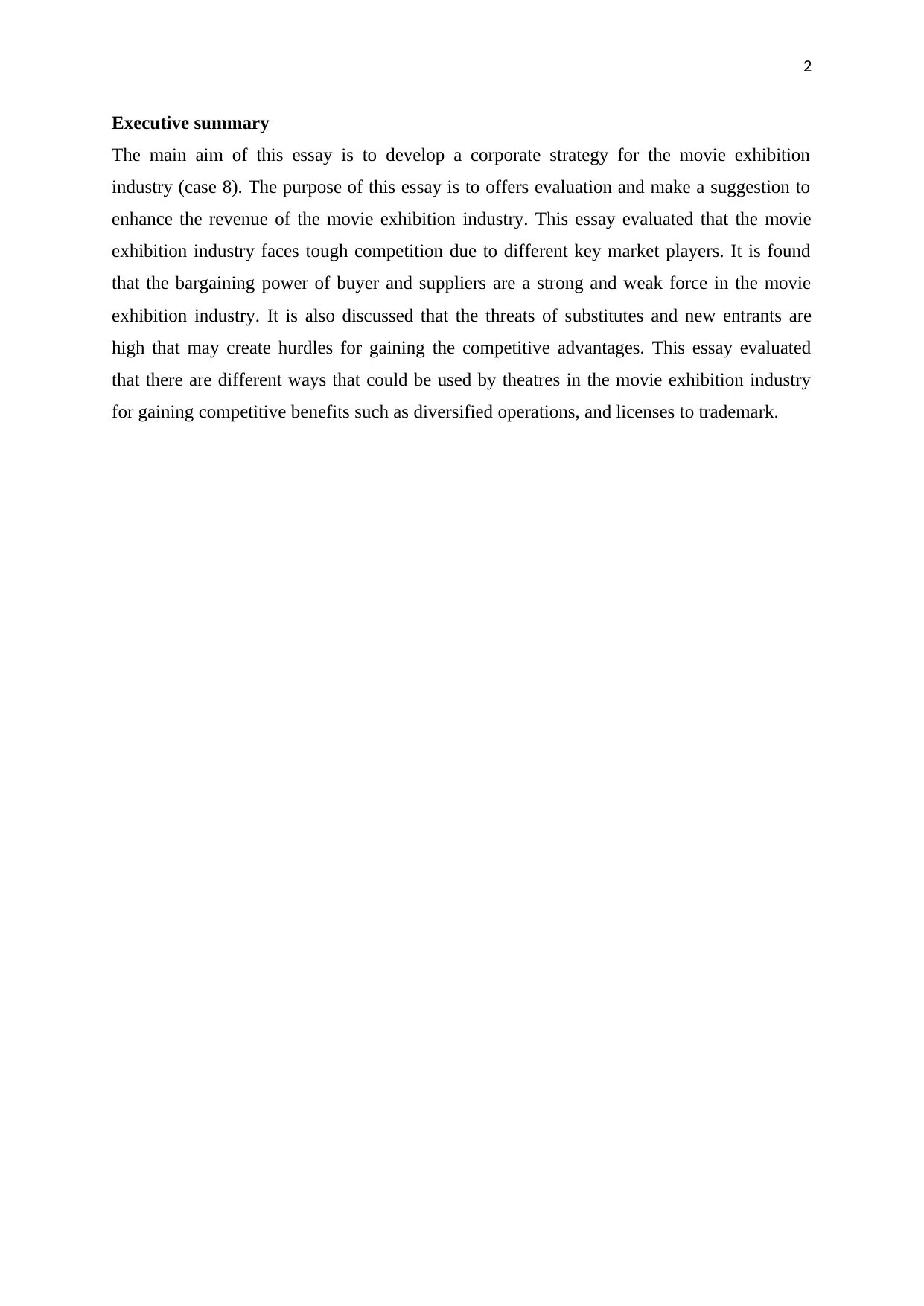
2
Executive summary
The main aim of this essay is to develop a corporate strategy for the movie exhibition
industry (case 8). The purpose of this essay is to offers evaluation and make a suggestion to
enhance the revenue of the movie exhibition industry. This essay evaluated that the movie
exhibition industry faces tough competition due to different key market players. It is found
that the bargaining power of buyer and suppliers are a strong and weak force in the movie
exhibition industry. It is also discussed that the threats of substitutes and new entrants are
high that may create hurdles for gaining the competitive advantages. This essay evaluated
that there are different ways that could be used by theatres in the movie exhibition industry
for gaining competitive benefits such as diversified operations, and licenses to trademark.
Executive summary
The main aim of this essay is to develop a corporate strategy for the movie exhibition
industry (case 8). The purpose of this essay is to offers evaluation and make a suggestion to
enhance the revenue of the movie exhibition industry. This essay evaluated that the movie
exhibition industry faces tough competition due to different key market players. It is found
that the bargaining power of buyer and suppliers are a strong and weak force in the movie
exhibition industry. It is also discussed that the threats of substitutes and new entrants are
high that may create hurdles for gaining the competitive advantages. This essay evaluated
that there are different ways that could be used by theatres in the movie exhibition industry
for gaining competitive benefits such as diversified operations, and licenses to trademark.
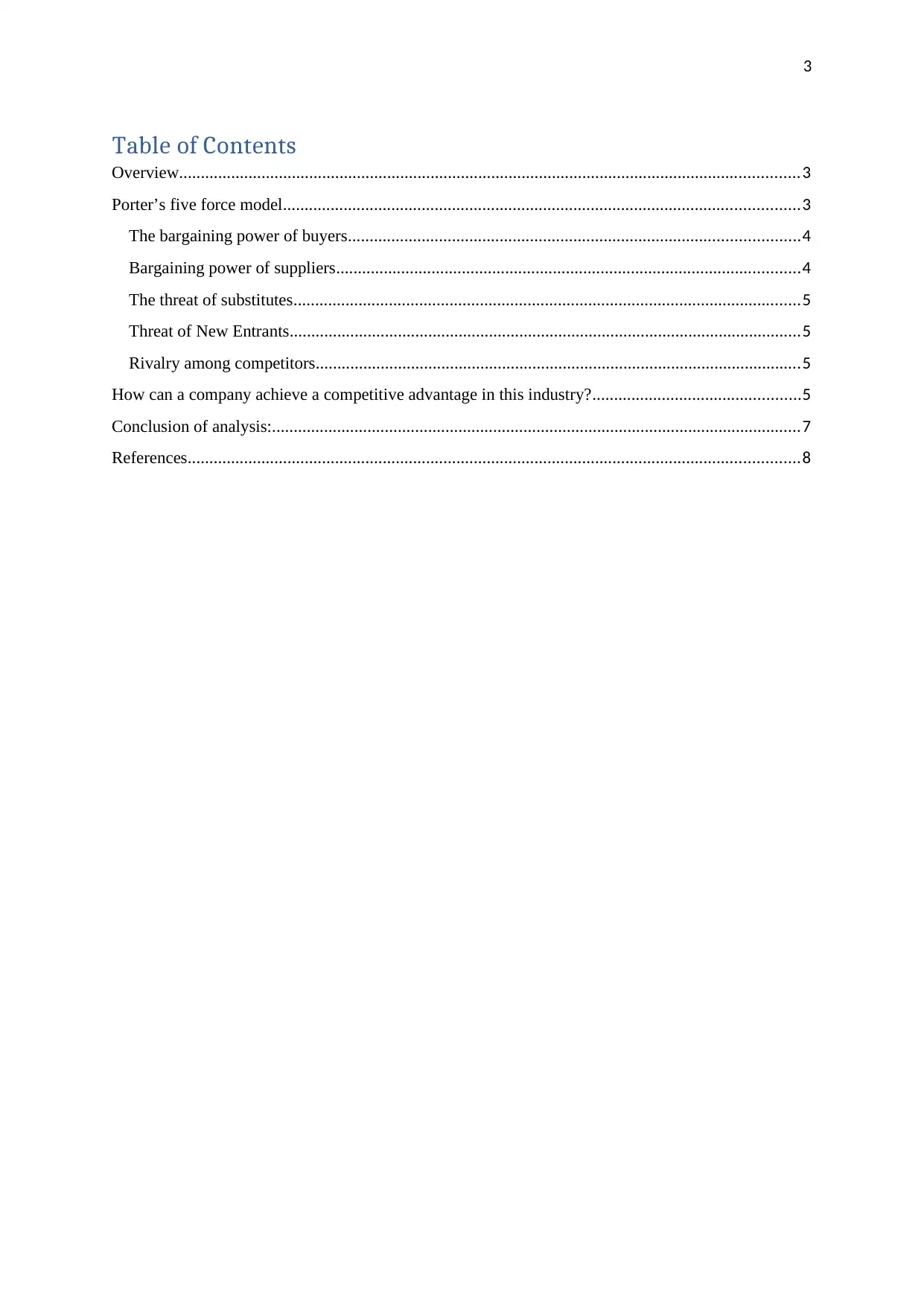
3
Table of Contents
Overview...............................................................................................................................................3
Porter’s five force model.......................................................................................................................3
The bargaining power of buyers........................................................................................................4
Bargaining power of suppliers...........................................................................................................4
The threat of substitutes.....................................................................................................................5
Threat of New Entrants......................................................................................................................5
Rivalry among competitors................................................................................................................5
How can a company achieve a competitive advantage in this industry?................................................5
Conclusion of analysis:..........................................................................................................................7
References.............................................................................................................................................8
Table of Contents
Overview...............................................................................................................................................3
Porter’s five force model.......................................................................................................................3
The bargaining power of buyers........................................................................................................4
Bargaining power of suppliers...........................................................................................................4
The threat of substitutes.....................................................................................................................5
Threat of New Entrants......................................................................................................................5
Rivalry among competitors................................................................................................................5
How can a company achieve a competitive advantage in this industry?................................................5
Conclusion of analysis:..........................................................................................................................7
References.............................................................................................................................................8
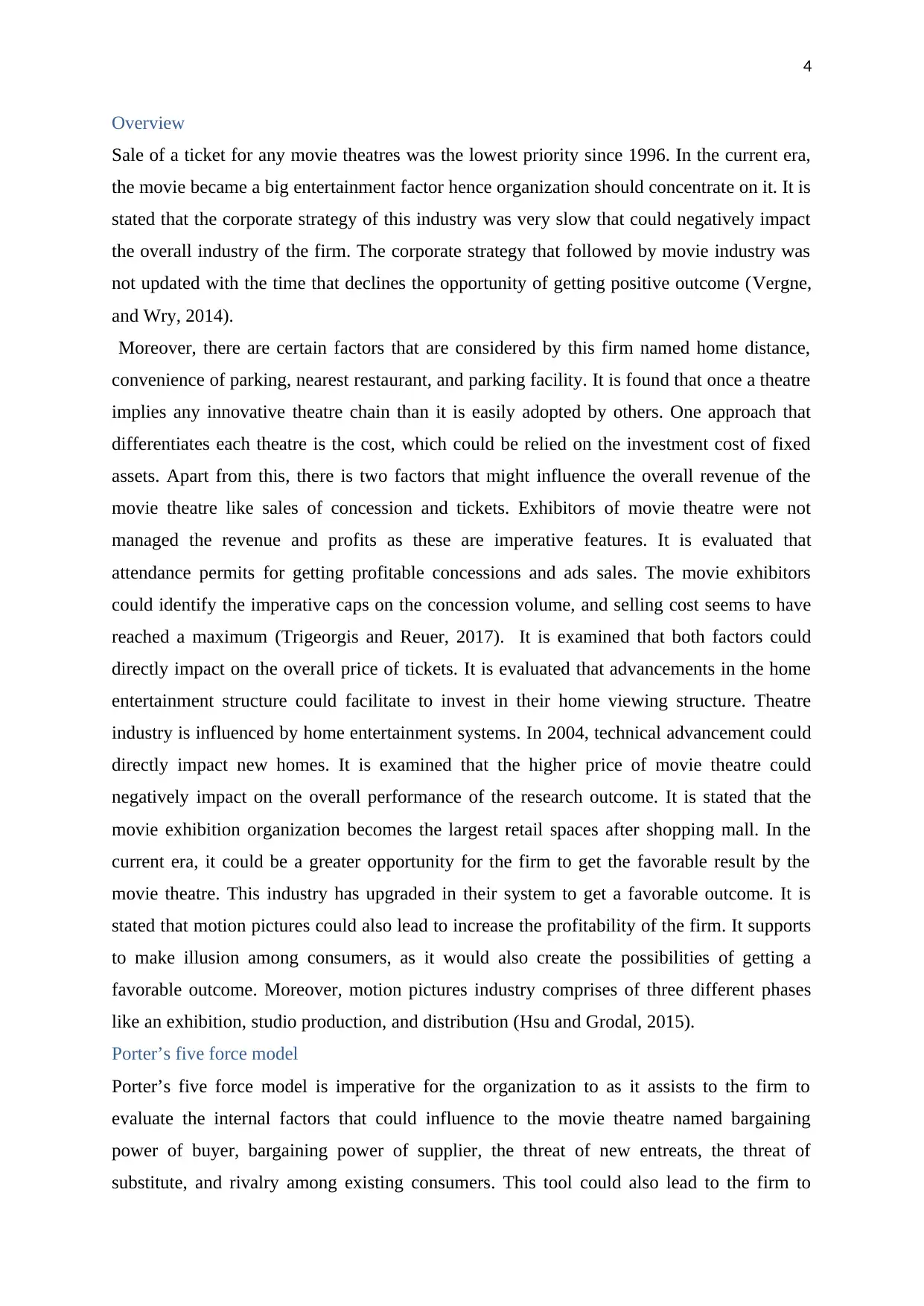
4
Overview
Sale of a ticket for any movie theatres was the lowest priority since 1996. In the current era,
the movie became a big entertainment factor hence organization should concentrate on it. It is
stated that the corporate strategy of this industry was very slow that could negatively impact
the overall industry of the firm. The corporate strategy that followed by movie industry was
not updated with the time that declines the opportunity of getting positive outcome (Vergne,
and Wry, 2014).
Moreover, there are certain factors that are considered by this firm named home distance,
convenience of parking, nearest restaurant, and parking facility. It is found that once a theatre
implies any innovative theatre chain than it is easily adopted by others. One approach that
differentiates each theatre is the cost, which could be relied on the investment cost of fixed
assets. Apart from this, there is two factors that might influence the overall revenue of the
movie theatre like sales of concession and tickets. Exhibitors of movie theatre were not
managed the revenue and profits as these are imperative features. It is evaluated that
attendance permits for getting profitable concessions and ads sales. The movie exhibitors
could identify the imperative caps on the concession volume, and selling cost seems to have
reached a maximum (Trigeorgis and Reuer, 2017). It is examined that both factors could
directly impact on the overall price of tickets. It is evaluated that advancements in the home
entertainment structure could facilitate to invest in their home viewing structure. Theatre
industry is influenced by home entertainment systems. In 2004, technical advancement could
directly impact new homes. It is examined that the higher price of movie theatre could
negatively impact on the overall performance of the research outcome. It is stated that the
movie exhibition organization becomes the largest retail spaces after shopping mall. In the
current era, it could be a greater opportunity for the firm to get the favorable result by the
movie theatre. This industry has upgraded in their system to get a favorable outcome. It is
stated that motion pictures could also lead to increase the profitability of the firm. It supports
to make illusion among consumers, as it would also create the possibilities of getting a
favorable outcome. Moreover, motion pictures industry comprises of three different phases
like an exhibition, studio production, and distribution (Hsu and Grodal, 2015).
Porter’s five force model
Porter’s five force model is imperative for the organization to as it assists to the firm to
evaluate the internal factors that could influence to the movie theatre named bargaining
power of buyer, bargaining power of supplier, the threat of new entreats, the threat of
substitute, and rivalry among existing consumers. This tool could also lead to the firm to
Overview
Sale of a ticket for any movie theatres was the lowest priority since 1996. In the current era,
the movie became a big entertainment factor hence organization should concentrate on it. It is
stated that the corporate strategy of this industry was very slow that could negatively impact
the overall industry of the firm. The corporate strategy that followed by movie industry was
not updated with the time that declines the opportunity of getting positive outcome (Vergne,
and Wry, 2014).
Moreover, there are certain factors that are considered by this firm named home distance,
convenience of parking, nearest restaurant, and parking facility. It is found that once a theatre
implies any innovative theatre chain than it is easily adopted by others. One approach that
differentiates each theatre is the cost, which could be relied on the investment cost of fixed
assets. Apart from this, there is two factors that might influence the overall revenue of the
movie theatre like sales of concession and tickets. Exhibitors of movie theatre were not
managed the revenue and profits as these are imperative features. It is evaluated that
attendance permits for getting profitable concessions and ads sales. The movie exhibitors
could identify the imperative caps on the concession volume, and selling cost seems to have
reached a maximum (Trigeorgis and Reuer, 2017). It is examined that both factors could
directly impact on the overall price of tickets. It is evaluated that advancements in the home
entertainment structure could facilitate to invest in their home viewing structure. Theatre
industry is influenced by home entertainment systems. In 2004, technical advancement could
directly impact new homes. It is examined that the higher price of movie theatre could
negatively impact on the overall performance of the research outcome. It is stated that the
movie exhibition organization becomes the largest retail spaces after shopping mall. In the
current era, it could be a greater opportunity for the firm to get the favorable result by the
movie theatre. This industry has upgraded in their system to get a favorable outcome. It is
stated that motion pictures could also lead to increase the profitability of the firm. It supports
to make illusion among consumers, as it would also create the possibilities of getting a
favorable outcome. Moreover, motion pictures industry comprises of three different phases
like an exhibition, studio production, and distribution (Hsu and Grodal, 2015).
Porter’s five force model
Porter’s five force model is imperative for the organization to as it assists to the firm to
evaluate the internal factors that could influence to the movie theatre named bargaining
power of buyer, bargaining power of supplier, the threat of new entreats, the threat of
substitute, and rivalry among existing consumers. This tool could also lead to the firm to
Secure Best Marks with AI Grader
Need help grading? Try our AI Grader for instant feedback on your assignments.
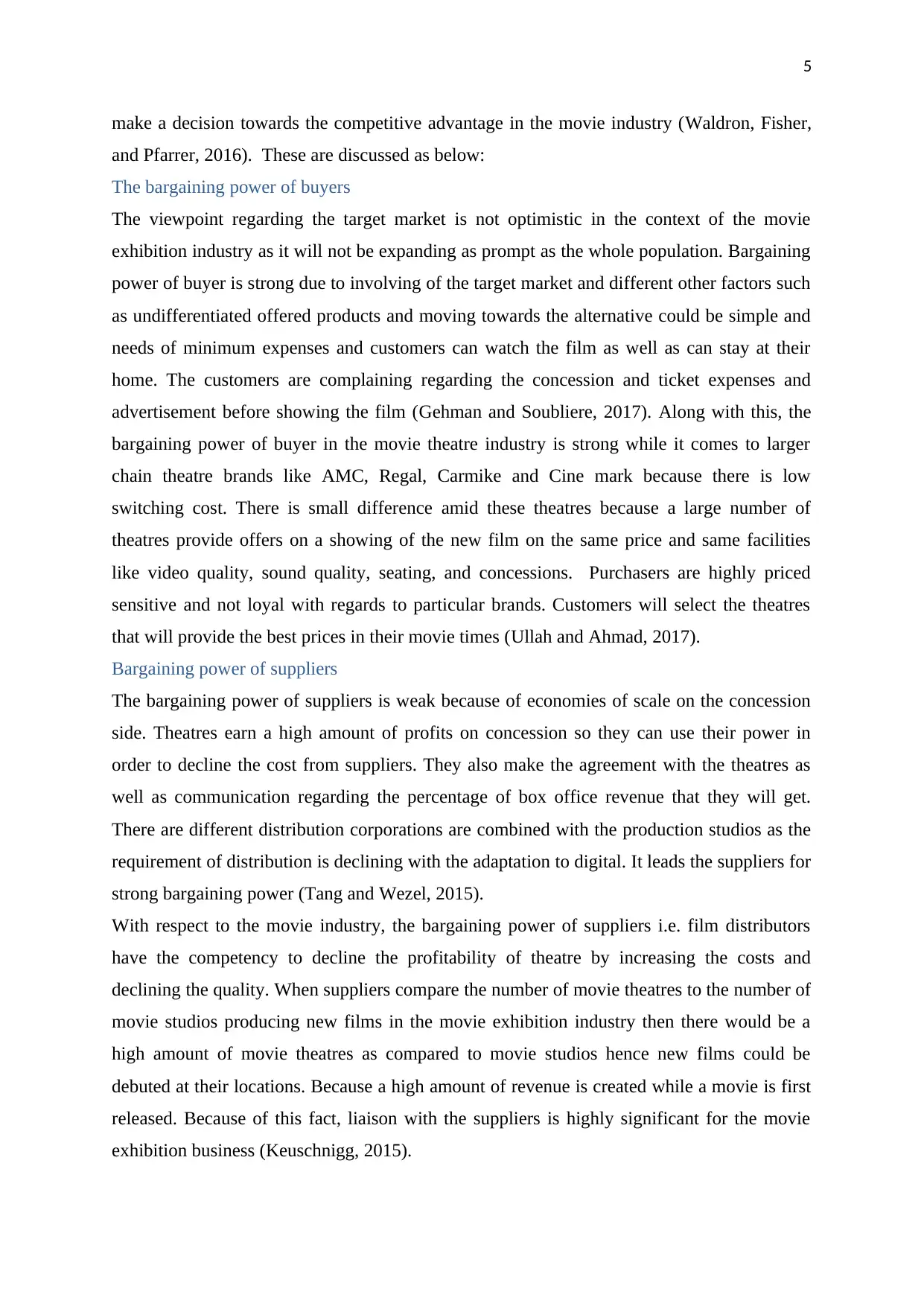
5
make a decision towards the competitive advantage in the movie industry (Waldron, Fisher,
and Pfarrer, 2016). These are discussed as below:
The bargaining power of buyers
The viewpoint regarding the target market is not optimistic in the context of the movie
exhibition industry as it will not be expanding as prompt as the whole population. Bargaining
power of buyer is strong due to involving of the target market and different other factors such
as undifferentiated offered products and moving towards the alternative could be simple and
needs of minimum expenses and customers can watch the film as well as can stay at their
home. The customers are complaining regarding the concession and ticket expenses and
advertisement before showing the film (Gehman and Soubliere, 2017). Along with this, the
bargaining power of buyer in the movie theatre industry is strong while it comes to larger
chain theatre brands like AMC, Regal, Carmike and Cine mark because there is low
switching cost. There is small difference amid these theatres because a large number of
theatres provide offers on a showing of the new film on the same price and same facilities
like video quality, sound quality, seating, and concessions. Purchasers are highly priced
sensitive and not loyal with regards to particular brands. Customers will select the theatres
that will provide the best prices in their movie times (Ullah and Ahmad, 2017).
Bargaining power of suppliers
The bargaining power of suppliers is weak because of economies of scale on the concession
side. Theatres earn a high amount of profits on concession so they can use their power in
order to decline the cost from suppliers. They also make the agreement with the theatres as
well as communication regarding the percentage of box office revenue that they will get.
There are different distribution corporations are combined with the production studios as the
requirement of distribution is declining with the adaptation to digital. It leads the suppliers for
strong bargaining power (Tang and Wezel, 2015).
With respect to the movie industry, the bargaining power of suppliers i.e. film distributors
have the competency to decline the profitability of theatre by increasing the costs and
declining the quality. When suppliers compare the number of movie theatres to the number of
movie studios producing new films in the movie exhibition industry then there would be a
high amount of movie theatres as compared to movie studios hence new films could be
debuted at their locations. Because a high amount of revenue is created while a movie is first
released. Because of this fact, liaison with the suppliers is highly significant for the movie
exhibition business (Keuschnigg, 2015).
make a decision towards the competitive advantage in the movie industry (Waldron, Fisher,
and Pfarrer, 2016). These are discussed as below:
The bargaining power of buyers
The viewpoint regarding the target market is not optimistic in the context of the movie
exhibition industry as it will not be expanding as prompt as the whole population. Bargaining
power of buyer is strong due to involving of the target market and different other factors such
as undifferentiated offered products and moving towards the alternative could be simple and
needs of minimum expenses and customers can watch the film as well as can stay at their
home. The customers are complaining regarding the concession and ticket expenses and
advertisement before showing the film (Gehman and Soubliere, 2017). Along with this, the
bargaining power of buyer in the movie theatre industry is strong while it comes to larger
chain theatre brands like AMC, Regal, Carmike and Cine mark because there is low
switching cost. There is small difference amid these theatres because a large number of
theatres provide offers on a showing of the new film on the same price and same facilities
like video quality, sound quality, seating, and concessions. Purchasers are highly priced
sensitive and not loyal with regards to particular brands. Customers will select the theatres
that will provide the best prices in their movie times (Ullah and Ahmad, 2017).
Bargaining power of suppliers
The bargaining power of suppliers is weak because of economies of scale on the concession
side. Theatres earn a high amount of profits on concession so they can use their power in
order to decline the cost from suppliers. They also make the agreement with the theatres as
well as communication regarding the percentage of box office revenue that they will get.
There are different distribution corporations are combined with the production studios as the
requirement of distribution is declining with the adaptation to digital. It leads the suppliers for
strong bargaining power (Tang and Wezel, 2015).
With respect to the movie industry, the bargaining power of suppliers i.e. film distributors
have the competency to decline the profitability of theatre by increasing the costs and
declining the quality. When suppliers compare the number of movie theatres to the number of
movie studios producing new films in the movie exhibition industry then there would be a
high amount of movie theatres as compared to movie studios hence new films could be
debuted at their locations. Because a high amount of revenue is created while a movie is first
released. Because of this fact, liaison with the suppliers is highly significant for the movie
exhibition business (Keuschnigg, 2015).
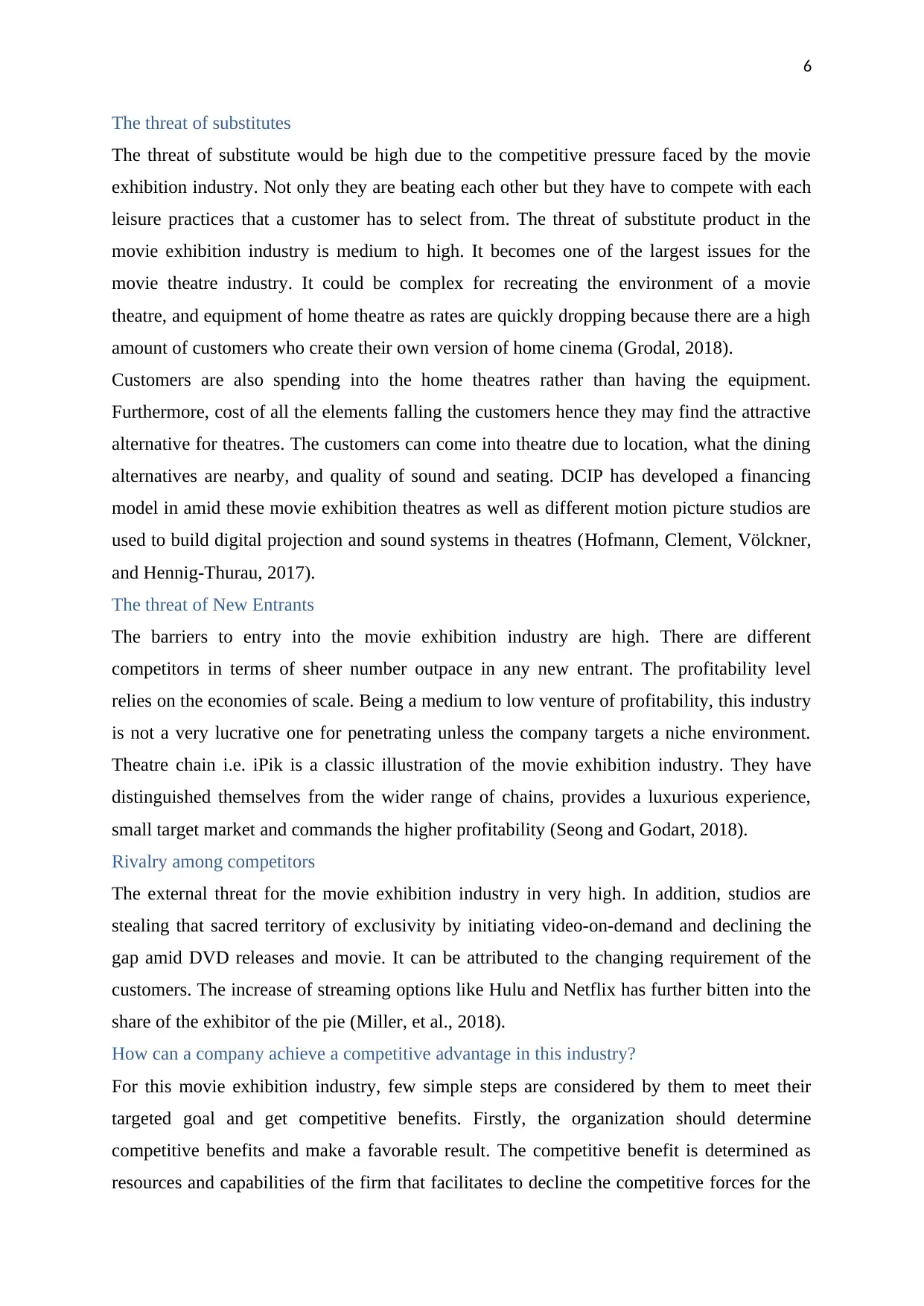
6
The threat of substitutes
The threat of substitute would be high due to the competitive pressure faced by the movie
exhibition industry. Not only they are beating each other but they have to compete with each
leisure practices that a customer has to select from. The threat of substitute product in the
movie exhibition industry is medium to high. It becomes one of the largest issues for the
movie theatre industry. It could be complex for recreating the environment of a movie
theatre, and equipment of home theatre as rates are quickly dropping because there are a high
amount of customers who create their own version of home cinema (Grodal, 2018).
Customers are also spending into the home theatres rather than having the equipment.
Furthermore, cost of all the elements falling the customers hence they may find the attractive
alternative for theatres. The customers can come into theatre due to location, what the dining
alternatives are nearby, and quality of sound and seating. DCIP has developed a financing
model in amid these movie exhibition theatres as well as different motion picture studios are
used to build digital projection and sound systems in theatres (Hofmann, Clement, Völckner,
and Hennig-Thurau, 2017).
The threat of New Entrants
The barriers to entry into the movie exhibition industry are high. There are different
competitors in terms of sheer number outpace in any new entrant. The profitability level
relies on the economies of scale. Being a medium to low venture of profitability, this industry
is not a very lucrative one for penetrating unless the company targets a niche environment.
Theatre chain i.e. iPik is a classic illustration of the movie exhibition industry. They have
distinguished themselves from the wider range of chains, provides a luxurious experience,
small target market and commands the higher profitability (Seong and Godart, 2018).
Rivalry among competitors
The external threat for the movie exhibition industry in very high. In addition, studios are
stealing that sacred territory of exclusivity by initiating video-on-demand and declining the
gap amid DVD releases and movie. It can be attributed to the changing requirement of the
customers. The increase of streaming options like Hulu and Netflix has further bitten into the
share of the exhibitor of the pie (Miller, et al., 2018).
How can a company achieve a competitive advantage in this industry?
For this movie exhibition industry, few simple steps are considered by them to meet their
targeted goal and get competitive benefits. Firstly, the organization should determine
competitive benefits and make a favorable result. The competitive benefit is determined as
resources and capabilities of the firm that facilitates to decline the competitive forces for the
The threat of substitutes
The threat of substitute would be high due to the competitive pressure faced by the movie
exhibition industry. Not only they are beating each other but they have to compete with each
leisure practices that a customer has to select from. The threat of substitute product in the
movie exhibition industry is medium to high. It becomes one of the largest issues for the
movie theatre industry. It could be complex for recreating the environment of a movie
theatre, and equipment of home theatre as rates are quickly dropping because there are a high
amount of customers who create their own version of home cinema (Grodal, 2018).
Customers are also spending into the home theatres rather than having the equipment.
Furthermore, cost of all the elements falling the customers hence they may find the attractive
alternative for theatres. The customers can come into theatre due to location, what the dining
alternatives are nearby, and quality of sound and seating. DCIP has developed a financing
model in amid these movie exhibition theatres as well as different motion picture studios are
used to build digital projection and sound systems in theatres (Hofmann, Clement, Völckner,
and Hennig-Thurau, 2017).
The threat of New Entrants
The barriers to entry into the movie exhibition industry are high. There are different
competitors in terms of sheer number outpace in any new entrant. The profitability level
relies on the economies of scale. Being a medium to low venture of profitability, this industry
is not a very lucrative one for penetrating unless the company targets a niche environment.
Theatre chain i.e. iPik is a classic illustration of the movie exhibition industry. They have
distinguished themselves from the wider range of chains, provides a luxurious experience,
small target market and commands the higher profitability (Seong and Godart, 2018).
Rivalry among competitors
The external threat for the movie exhibition industry in very high. In addition, studios are
stealing that sacred territory of exclusivity by initiating video-on-demand and declining the
gap amid DVD releases and movie. It can be attributed to the changing requirement of the
customers. The increase of streaming options like Hulu and Netflix has further bitten into the
share of the exhibitor of the pie (Miller, et al., 2018).
How can a company achieve a competitive advantage in this industry?
For this movie exhibition industry, few simple steps are considered by them to meet their
targeted goal and get competitive benefits. Firstly, the organization should determine
competitive benefits and make a favorable result. The competitive benefit is determined as
resources and capabilities of the firm that facilitates to decline the competitive forces for the
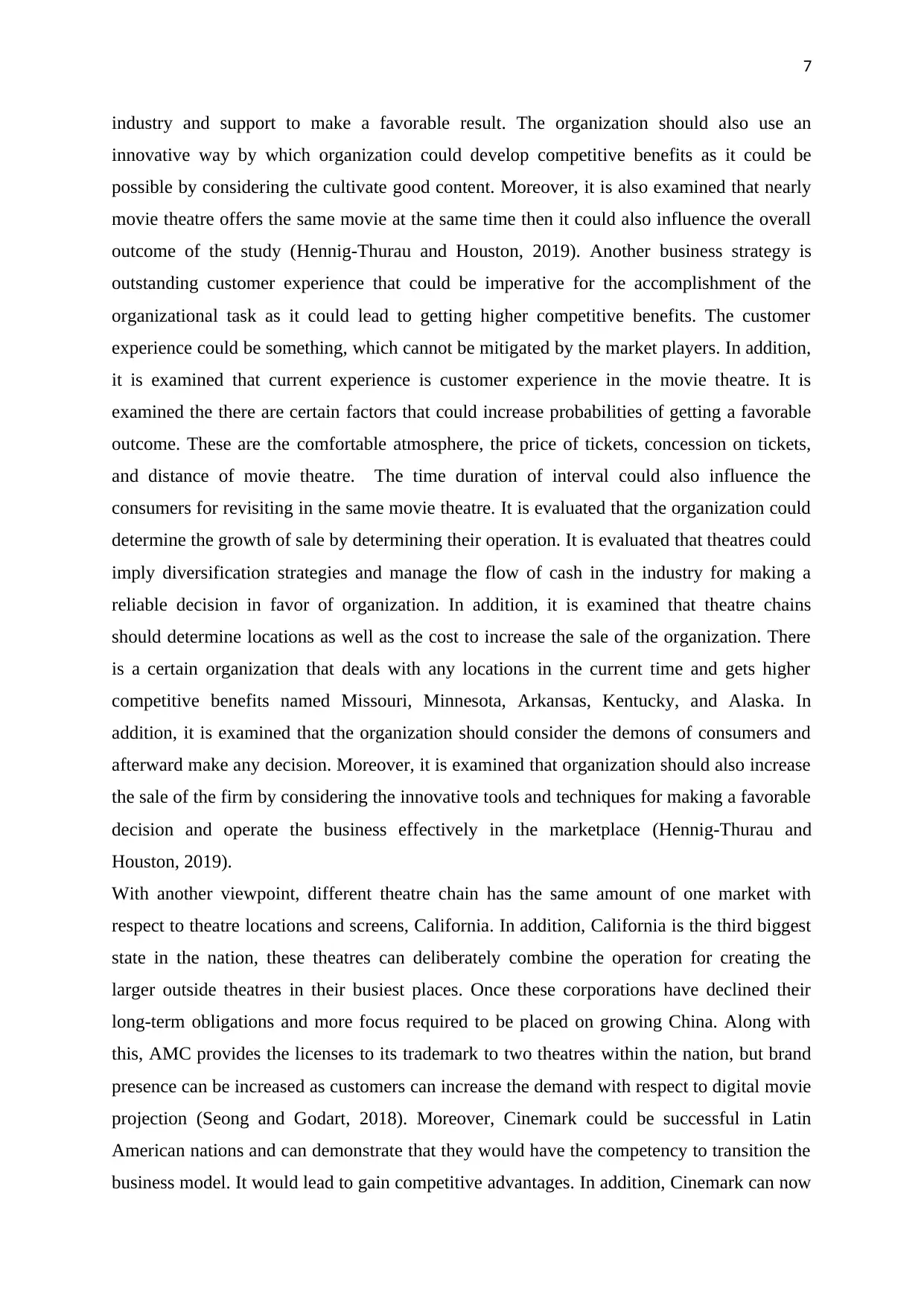
7
industry and support to make a favorable result. The organization should also use an
innovative way by which organization could develop competitive benefits as it could be
possible by considering the cultivate good content. Moreover, it is also examined that nearly
movie theatre offers the same movie at the same time then it could also influence the overall
outcome of the study (Hennig-Thurau and Houston, 2019). Another business strategy is
outstanding customer experience that could be imperative for the accomplishment of the
organizational task as it could lead to getting higher competitive benefits. The customer
experience could be something, which cannot be mitigated by the market players. In addition,
it is examined that current experience is customer experience in the movie theatre. It is
examined the there are certain factors that could increase probabilities of getting a favorable
outcome. These are the comfortable atmosphere, the price of tickets, concession on tickets,
and distance of movie theatre. The time duration of interval could also influence the
consumers for revisiting in the same movie theatre. It is evaluated that the organization could
determine the growth of sale by determining their operation. It is evaluated that theatres could
imply diversification strategies and manage the flow of cash in the industry for making a
reliable decision in favor of organization. In addition, it is examined that theatre chains
should determine locations as well as the cost to increase the sale of the organization. There
is a certain organization that deals with any locations in the current time and gets higher
competitive benefits named Missouri, Minnesota, Arkansas, Kentucky, and Alaska. In
addition, it is examined that the organization should consider the demons of consumers and
afterward make any decision. Moreover, it is examined that organization should also increase
the sale of the firm by considering the innovative tools and techniques for making a favorable
decision and operate the business effectively in the marketplace (Hennig-Thurau and
Houston, 2019).
With another viewpoint, different theatre chain has the same amount of one market with
respect to theatre locations and screens, California. In addition, California is the third biggest
state in the nation, these theatres can deliberately combine the operation for creating the
larger outside theatres in their busiest places. Once these corporations have declined their
long-term obligations and more focus required to be placed on growing China. Along with
this, AMC provides the licenses to its trademark to two theatres within the nation, but brand
presence can be increased as customers can increase the demand with respect to digital movie
projection (Seong and Godart, 2018). Moreover, Cinemark could be successful in Latin
American nations and can demonstrate that they would have the competency to transition the
business model. It would lead to gain competitive advantages. In addition, Cinemark can now
industry and support to make a favorable result. The organization should also use an
innovative way by which organization could develop competitive benefits as it could be
possible by considering the cultivate good content. Moreover, it is also examined that nearly
movie theatre offers the same movie at the same time then it could also influence the overall
outcome of the study (Hennig-Thurau and Houston, 2019). Another business strategy is
outstanding customer experience that could be imperative for the accomplishment of the
organizational task as it could lead to getting higher competitive benefits. The customer
experience could be something, which cannot be mitigated by the market players. In addition,
it is examined that current experience is customer experience in the movie theatre. It is
examined the there are certain factors that could increase probabilities of getting a favorable
outcome. These are the comfortable atmosphere, the price of tickets, concession on tickets,
and distance of movie theatre. The time duration of interval could also influence the
consumers for revisiting in the same movie theatre. It is evaluated that the organization could
determine the growth of sale by determining their operation. It is evaluated that theatres could
imply diversification strategies and manage the flow of cash in the industry for making a
reliable decision in favor of organization. In addition, it is examined that theatre chains
should determine locations as well as the cost to increase the sale of the organization. There
is a certain organization that deals with any locations in the current time and gets higher
competitive benefits named Missouri, Minnesota, Arkansas, Kentucky, and Alaska. In
addition, it is examined that the organization should consider the demons of consumers and
afterward make any decision. Moreover, it is examined that organization should also increase
the sale of the firm by considering the innovative tools and techniques for making a favorable
decision and operate the business effectively in the marketplace (Hennig-Thurau and
Houston, 2019).
With another viewpoint, different theatre chain has the same amount of one market with
respect to theatre locations and screens, California. In addition, California is the third biggest
state in the nation, these theatres can deliberately combine the operation for creating the
larger outside theatres in their busiest places. Once these corporations have declined their
long-term obligations and more focus required to be placed on growing China. Along with
this, AMC provides the licenses to its trademark to two theatres within the nation, but brand
presence can be increased as customers can increase the demand with respect to digital movie
projection (Seong and Godart, 2018). Moreover, Cinemark could be successful in Latin
American nations and can demonstrate that they would have the competency to transition the
business model. It would lead to gain competitive advantages. In addition, Cinemark can now
Paraphrase This Document
Need a fresh take? Get an instant paraphrase of this document with our AI Paraphraser
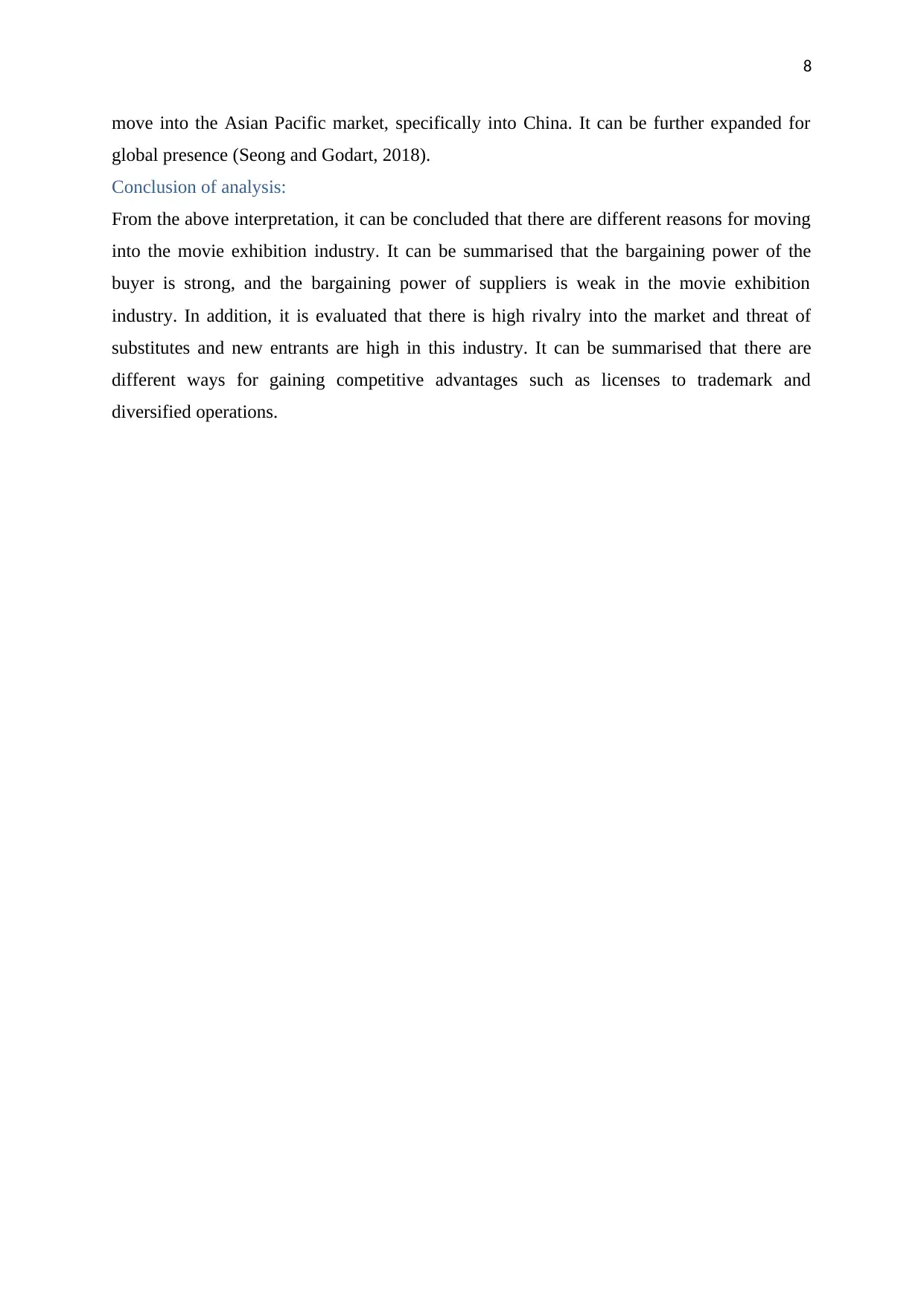
8
move into the Asian Pacific market, specifically into China. It can be further expanded for
global presence (Seong and Godart, 2018).
Conclusion of analysis:
From the above interpretation, it can be concluded that there are different reasons for moving
into the movie exhibition industry. It can be summarised that the bargaining power of the
buyer is strong, and the bargaining power of suppliers is weak in the movie exhibition
industry. In addition, it is evaluated that there is high rivalry into the market and threat of
substitutes and new entrants are high in this industry. It can be summarised that there are
different ways for gaining competitive advantages such as licenses to trademark and
diversified operations.
move into the Asian Pacific market, specifically into China. It can be further expanded for
global presence (Seong and Godart, 2018).
Conclusion of analysis:
From the above interpretation, it can be concluded that there are different reasons for moving
into the movie exhibition industry. It can be summarised that the bargaining power of the
buyer is strong, and the bargaining power of suppliers is weak in the movie exhibition
industry. In addition, it is evaluated that there is high rivalry into the market and threat of
substitutes and new entrants are high in this industry. It can be summarised that there are
different ways for gaining competitive advantages such as licenses to trademark and
diversified operations.
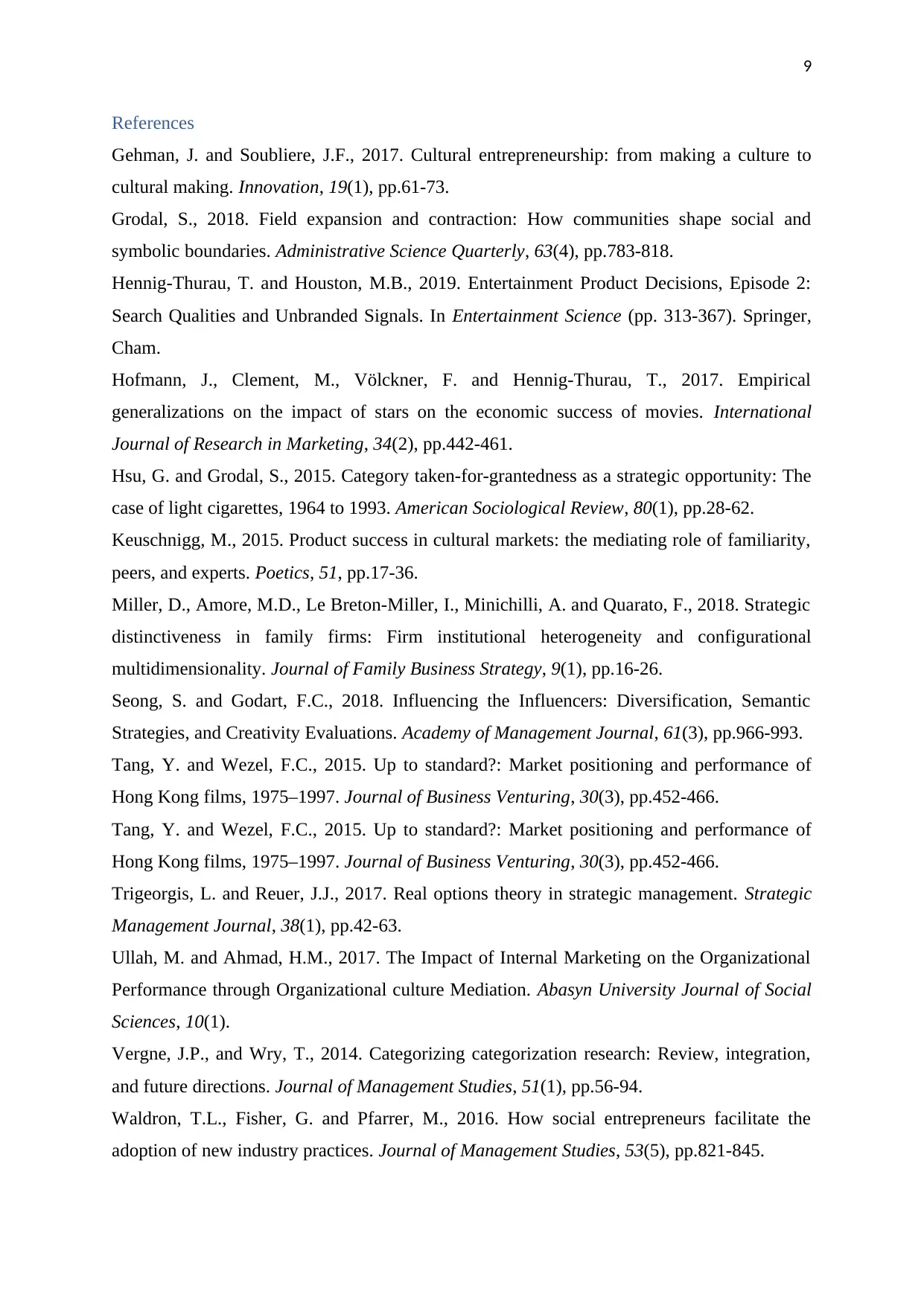
9
References
Gehman, J. and Soubliere, J.F., 2017. Cultural entrepreneurship: from making a culture to
cultural making. Innovation, 19(1), pp.61-73.
Grodal, S., 2018. Field expansion and contraction: How communities shape social and
symbolic boundaries. Administrative Science Quarterly, 63(4), pp.783-818.
Hennig-Thurau, T. and Houston, M.B., 2019. Entertainment Product Decisions, Episode 2:
Search Qualities and Unbranded Signals. In Entertainment Science (pp. 313-367). Springer,
Cham.
Hofmann, J., Clement, M., Völckner, F. and Hennig-Thurau, T., 2017. Empirical
generalizations on the impact of stars on the economic success of movies. International
Journal of Research in Marketing, 34(2), pp.442-461.
Hsu, G. and Grodal, S., 2015. Category taken-for-grantedness as a strategic opportunity: The
case of light cigarettes, 1964 to 1993. American Sociological Review, 80(1), pp.28-62.
Keuschnigg, M., 2015. Product success in cultural markets: the mediating role of familiarity,
peers, and experts. Poetics, 51, pp.17-36.
Miller, D., Amore, M.D., Le Breton-Miller, I., Minichilli, A. and Quarato, F., 2018. Strategic
distinctiveness in family firms: Firm institutional heterogeneity and configurational
multidimensionality. Journal of Family Business Strategy, 9(1), pp.16-26.
Seong, S. and Godart, F.C., 2018. Influencing the Influencers: Diversification, Semantic
Strategies, and Creativity Evaluations. Academy of Management Journal, 61(3), pp.966-993.
Tang, Y. and Wezel, F.C., 2015. Up to standard?: Market positioning and performance of
Hong Kong films, 1975–1997. Journal of Business Venturing, 30(3), pp.452-466.
Tang, Y. and Wezel, F.C., 2015. Up to standard?: Market positioning and performance of
Hong Kong films, 1975–1997. Journal of Business Venturing, 30(3), pp.452-466.
Trigeorgis, L. and Reuer, J.J., 2017. Real options theory in strategic management. Strategic
Management Journal, 38(1), pp.42-63.
Ullah, M. and Ahmad, H.M., 2017. The Impact of Internal Marketing on the Organizational
Performance through Organizational culture Mediation. Abasyn University Journal of Social
Sciences, 10(1).
Vergne, J.P., and Wry, T., 2014. Categorizing categorization research: Review, integration,
and future directions. Journal of Management Studies, 51(1), pp.56-94.
Waldron, T.L., Fisher, G. and Pfarrer, M., 2016. How social entrepreneurs facilitate the
adoption of new industry practices. Journal of Management Studies, 53(5), pp.821-845.
References
Gehman, J. and Soubliere, J.F., 2017. Cultural entrepreneurship: from making a culture to
cultural making. Innovation, 19(1), pp.61-73.
Grodal, S., 2018. Field expansion and contraction: How communities shape social and
symbolic boundaries. Administrative Science Quarterly, 63(4), pp.783-818.
Hennig-Thurau, T. and Houston, M.B., 2019. Entertainment Product Decisions, Episode 2:
Search Qualities and Unbranded Signals. In Entertainment Science (pp. 313-367). Springer,
Cham.
Hofmann, J., Clement, M., Völckner, F. and Hennig-Thurau, T., 2017. Empirical
generalizations on the impact of stars on the economic success of movies. International
Journal of Research in Marketing, 34(2), pp.442-461.
Hsu, G. and Grodal, S., 2015. Category taken-for-grantedness as a strategic opportunity: The
case of light cigarettes, 1964 to 1993. American Sociological Review, 80(1), pp.28-62.
Keuschnigg, M., 2015. Product success in cultural markets: the mediating role of familiarity,
peers, and experts. Poetics, 51, pp.17-36.
Miller, D., Amore, M.D., Le Breton-Miller, I., Minichilli, A. and Quarato, F., 2018. Strategic
distinctiveness in family firms: Firm institutional heterogeneity and configurational
multidimensionality. Journal of Family Business Strategy, 9(1), pp.16-26.
Seong, S. and Godart, F.C., 2018. Influencing the Influencers: Diversification, Semantic
Strategies, and Creativity Evaluations. Academy of Management Journal, 61(3), pp.966-993.
Tang, Y. and Wezel, F.C., 2015. Up to standard?: Market positioning and performance of
Hong Kong films, 1975–1997. Journal of Business Venturing, 30(3), pp.452-466.
Tang, Y. and Wezel, F.C., 2015. Up to standard?: Market positioning and performance of
Hong Kong films, 1975–1997. Journal of Business Venturing, 30(3), pp.452-466.
Trigeorgis, L. and Reuer, J.J., 2017. Real options theory in strategic management. Strategic
Management Journal, 38(1), pp.42-63.
Ullah, M. and Ahmad, H.M., 2017. The Impact of Internal Marketing on the Organizational
Performance through Organizational culture Mediation. Abasyn University Journal of Social
Sciences, 10(1).
Vergne, J.P., and Wry, T., 2014. Categorizing categorization research: Review, integration,
and future directions. Journal of Management Studies, 51(1), pp.56-94.
Waldron, T.L., Fisher, G. and Pfarrer, M., 2016. How social entrepreneurs facilitate the
adoption of new industry practices. Journal of Management Studies, 53(5), pp.821-845.

10
1 out of 10
Related Documents
Your All-in-One AI-Powered Toolkit for Academic Success.
+13062052269
info@desklib.com
Available 24*7 on WhatsApp / Email
![[object Object]](/_next/static/media/star-bottom.7253800d.svg)
Unlock your academic potential
© 2024 | Zucol Services PVT LTD | All rights reserved.




